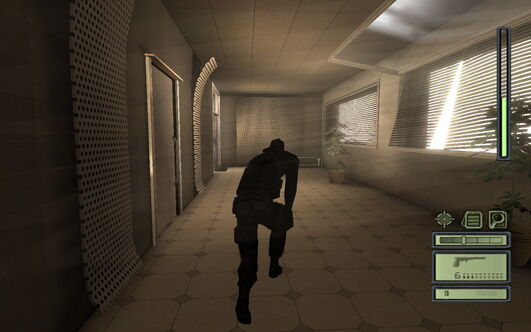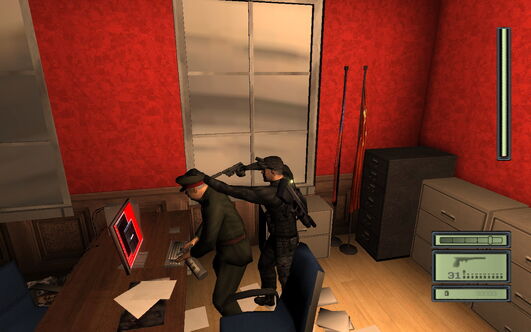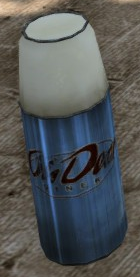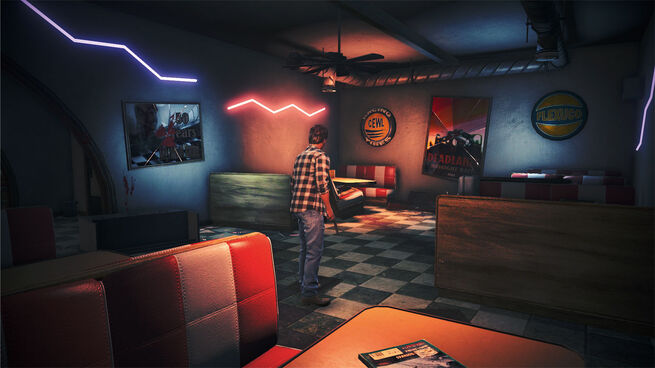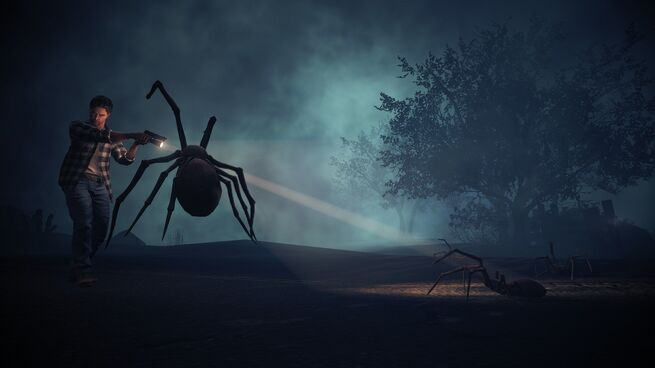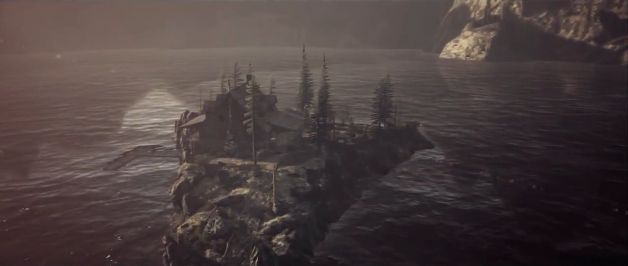If you've read
part three of my video game “memoir” series, you might remember that some of my earliest digital gaming experiences had to do with text-based adventures. I talked a little bit about
King's Quest in particular.
King's Quest was an interesting type of game that was both a graphics- and
text-based adventure. In it the player moved the character avatar around a set of static location screens using either keyboard directional buttons or by clicking with a mouse cursor. This, however, was purely for navigational purposes. The primary system of player input was handled via written commands that the player literally would have to type into existence.

If a player walked up to the castle doors, they would have to type “open door” to actually open the door and proceed. If the player wanted to speak to the king, they would have to type “speak to king.” Later on in the game these text-based commands became a little more puzzling. The player might wander into an exterior environment and have to type something like “look at room,” a basic command that usually would provide a rudimentary description of the environment immediately depicted on-screen. This visual description might even hone in on a particular object of player interest—perhaps a particular rock that required pushing or a tree to climb.
This system of text-driven input had its roots in earlier games such as the
Zork series—the first of which were text-only adventures—and carried over into other adventure games for several years until pretty much the entire adventure game genre switched over to a
point-and-click interface model. Instead of typing commands the player would select from various cursor icon types, each representing a specific type of action—an eye cursor for looking, a hand cursor for touching or taking objects, and a dialog cursor for speaking to people, things, etc. Other games employed similar systems, and they worked rather well for several more years. Then the adventure genre mostly disappeared.
This past January I downloaded
Boxer, an awesome DOS-emulator program, onto my Macintosh computer so that I could theoretically go and play, among other things, a bunch of those classic Sierra On-Line adventure games from back in the day. The first (and so far only) game I went through was a game called
Quest for Glory: So You Want to be a Hero, which I'd played to completion several times as a kid on our Macintosh Centris 610 computer.
I think the entire
Quest for Glory series (there were five original games in the series released between 1989 and 1998, as well as one remake) deserves a writeup all its own, but I'll just mention a couple noteworthy points. The
Quest for Glory series was an early and rare example of an adventure and role-playing game hybrid—arguably heavier on the former type of game. Long before BioWare's
Mass Effect series did the same, the
Quest for Glory games allowed the player to import their saved character file from one installment to the next, with all of that character's built-up statistics transported intact. Alternatively, one could create a new character file for each game, selecting from three optional character classes: fighter, magic user, and thief.

The version I played through this past January, same as the version I played through as a kid, was actually a 1991 remake of the original 1989 game (which also, incidentally, bore the original series title
Hero's Quest, changed to avoid copyright infringement with the
HeroQuest board games). Whereas the original game was a 16-color adventure with a text-parser input system, the remake was redone with completely redrawn 256-color graphics and a point-and-click user interface.
One aspect of the (remake) game that I had always enjoyed was its system of dialogue with non-playable characters. In all of the other Sierra adventure games I'd played, there really was no dialogue system at all. Speaking to other characters—whether initiated via text- or cursor-based command, depending on the particular game—was functionally no different from looking at something or performing any other type of action. In this
Quest for Glory remake, however, clicking the dialog cursor on a character brought up a menu of dialogue topics, sort of an early dialogue tree. Selecting one topic might cause that character to provide background information on related subjects, sometimes bringing up a new sub-menu with some of these new topics. It was an excellent vehicle, I thought, for communicating story and information.

After going through the game again, I was hoping to finally transport my character over to the sequel,
Quest for Glory II: Trial by Fire. This was something I never got to do as a kid, because that game—as far as I'm aware—was never released for the Macintosh.
My original plan was to play through the sequel using a 2008 fan-made remake version from a group called
AGD Interactive. Like the original
Quest for Glory (or, rather,
Hero's Quest),
Quest for Glory II had incorporated 16-color graphics and a text-input system. The fan remake was a redeveloped game with improved graphics and a point-and-click interface. Unfortunately, I was unable to get the game to run on my OSX computer. I also couldn't run it on my dinosaur PC laptop. At that point my only recourse was to try and run a pirated download version of the original
Quest for Glory II game, which didn't end up working on the Mac but luckily ran using
DOSBox on the PC laptop. Whew!
(I normally wouldn't condone using pirated software, but in this case there currently is no digital distribution service, such as
Good Old Games, for purchasing the
Quest for Glory titles. And there's absolutely no guarantee I would have been able to run the game through any kind of legitimate used e-Bay copy.)
I'm actually glad I played the original
Quest for Glory II in all of its original clunkiness. Again, I wish I could do better justice to this game with a more in-depth writeup. Maybe in the future. It would be very hard to recommend playing this game to anyone I know. It's primitive. It had some very strange design choices. Modern game players, with or without the background experience in old adventure games, would need the patience of Job to get through it. Even so, it's a fascinating kind of game. I quite enjoyed it myself.

If anything, playing the original
Quest for Glory II made me a newfound believer in the potential of text-based player input.
Recall what I was just saying about the cool dialogue menus in the remade
Quest for Glory I? At first I was baffled about how one was supposed to initiate dialogue in
Quest for Glory II. If I were to type simply “speak to [character],” nothing would happen. Then I looked at the program menus and noticed a keyboard shortcut for the text prompt beginning “ask about.”
Instead of just typing “speak to [character]” and being spoon fed a dialogue tree with pre-selected conversation topics, the player has to be specific regarding what they want the character to discuss. Functionally, gleaning information from a character might play out very similarly to the dialogue tree. Perhaps in asking about a particular city the character will mention the name of a person. Ask about that person and the character will divulge more specific information. But it's up to the player to make those connections and associations to new topics. Better yet, as the player progresses through the game and learns about new potential conversation topics from other sources, the player can go back to earlier characters and see if they have anything to say about that new topic. Sometimes they do.
I'm sure if
Quest for Glory II were converted to a modern game console there would be some kind of collectible achievement for activating every available dialogue window. In essence, there's nothing necessarily tangible gained from trying to “ask about” every single topic. But the typing system creates a playing experience that really is unlike almost any other. Accessing programmed content with the power of one's intuition is enjoyable. There's something to be said about being able try virtually anything, or of using one's brain power to find the necessary words, for initiating the type of action one might attempt for overcoming puzzles and obstacles.
Quest for Glory II and its contemporaries may have been primitive games by today's standards, but I find it somewhat sad how the use of text-based input in games was abandoned.
On the one hand, I suppose this kind of itch for unlimited player input could be partially satisfied through different kinds of table-top role-playing or other community-driven games. I can't speak from personal experience. But I think there's something almost mythical about the connection of the minds between a player and a programmer that has nothing to do with real-time interaction or ad-lib dialogue. This has to do with a game inventor who has put in place a specific framework for responding to the predicted input of an actual user. (On a total side note, I'm reminded of the
Foundation novel series by Isaac Asimov, dealing with “psychohistory” and the prediction of mass human behavior.)
When I was in middle school I went through a brief period where I tried programming and designing my own graphic adventure games using a Macintosh authoring system called
World Builder, released first in 1986 by Silicon Beach Software (the same company that made the game
Dark Castle) and later in 1995 as freeware. The program allowed users to create original adventure games using static black-and-white graphic screens and text.

This was an amazing piece of software, and there were a lot of
interesting, albeit obscure, games created because of it. What was really neat was being able to create my own vector graphics in Adobe
PageMaker and then copy and paste them into the
World Builder graphic design engine. Even better, using the
World Builder tool introduced me to a mode of simple computer programming, using a custom language similar to BASIC. For each static location I would have to create lines of codes that would correspond to player text prompts. For example, “IF a player types 'a', THEN 'b' happens.” I even figured out a way to use this programming to implement basic animations, such as a bird's-eye view of bungee jumping from off a bridge toward a river below (man, that segment was fun to make).
It was fun to try and think about the different things a player might type while playing and program specific feedback to that potential behavior. I also learned it's just as much fun to create special triggered events for even the more obscure types of actions that a player might attempt—a sort of reward for intrepid and like-minded individuals. Unfortunately, I never did manage to create a finished product, nor did I have any actual players test my bedroom project. What I did manage to get underway is likely still stored on our family's antique black-and-white Macintosh somewhere in my parents' attic.
I myself am not yearning for a resurrection of traditional adventure games (although, oddly enough, there may actually be somewhat of a demand for it … see
here and
here). But I do think there is potential in the idea of modern text-based game mechanics, particularly in the android/iOS market where a nifty keyboard is already right there.
On a basic level, it's actually just plain fun to see one's words brought to life in a game. Examples? I've heard people get to name their own weapons in
The Elder Scrolls V: Skyrim. That's awesome! There's also a neat and completely throwaway feature in Team Ninja's
Dead or Alive 4 fighting game. The game copies the text from the user's Xbox 360 profile motto and displays it on various electronic billboard banners in some of the fighting environments. It's pretty funny when beginning a virtual fight in a large packed-housed stadium and seeing my limited-character motto (“4 me 2 P@@P on”) displayed in gigantic moving text all around the enormous room.
On a larger scale, I wonder what might have happened if the idea of text-based commands had not been so completely abandoned. What if that type of system had survived, adapted to and evolved with modern games? What if we had a type of game today—like the
Mass Effect series—that incorporated the individual choices of the player on an even more sophisticated level? What if these games involved complex and dynamic consequences resulting not just from the choices directly presented to the player but from the ones the player came up with independently?


